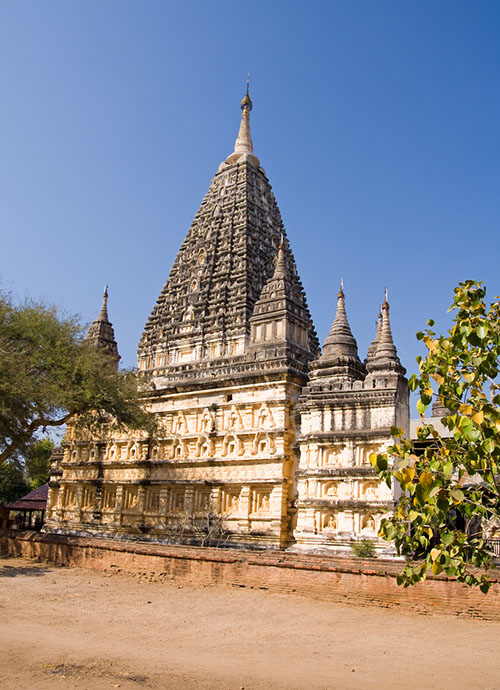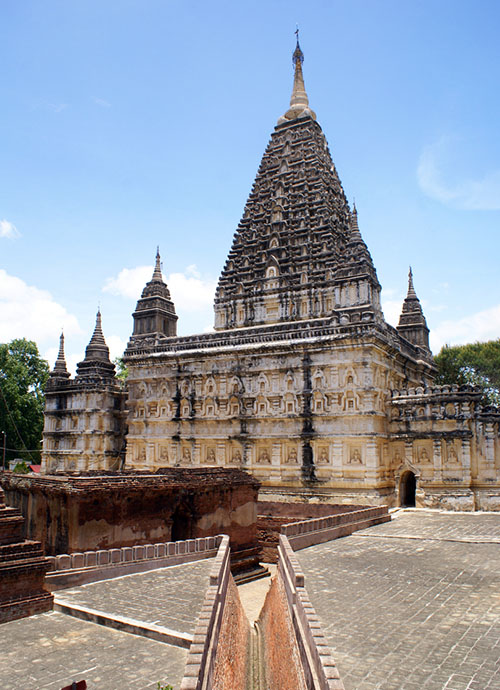
Mahabodhi temple
Build after the Mahabodhi temple of Bodh Gaya, India
Two storey structure
Indian style
The Mahabodhi pagoda within the city walls of old Bagan is a monument in a style that is unique to Bagan. The pagoda was build to resemble the Mahabodhi temple in Bodh Gaya in North India, the place where the Buddha reached enlightenment some 25 centuries ago.
The temple is a two storey structure about 43 meters high. The pagoda and its square base are stuccoed and contain depictions of several animals and Nat spirit figures.
465 Buddha images in niches
The base of the structure consists of a square block. On each of its four corners are smaller versions of the stupa. Both the base and tower contain numerous niches, in which 465 Buddha images in different postures are enshrined.
Tower topped with golden hti
On top of the base is a conical tower topped with a golden hti, an ornamental spire found most Burmese temples.
Both the lower and upper storey of the Mahabodhi temple contain a large seated Buddha image. On the inner wall is an inscription that provides information about the donation of the land where the temple was build on.
Other structures in the temple complex
Another structure in the Mahabodhi temple complex is the gem house called Ratana Gara which contained a beautifully decorated alter piece which was badly damaged during the 1975 earthquake. The alter piece is now on display in the Bagan archaeological museum. The grounds also contain a brick circular stupa set on a square base.

The seven weeks the Buddha spend after reaching enlightenment
Seven places near the Mahabodhi temple represent the seven weeks the Buddha spent after reaching enlightenment.
The first week the Buddha sat under the Bodhi tree where he had reached enlightenment.
The second week the Buddha spend looking in appreciation at the Bodhi tree that had sheltered him during meditation.
The third week the Buddha created a golden bridge in the air in order to demonstrate he had reached enlightenment and spend a week walking up and down the bridge.
The fourth week the Buddha created a jeweled chamber and meditated inside it. This chamber is represented by the Ratana Gara gem house.
The fifth week the Buddha spend meditating under a Banyan tree. Three beautiful girls, said to be the daughters of the demon Mara, danced in front of him in an unsuccessful attempt to stop the Buddha from meditating.
The sixth week the Buddha meditated under a Mucalinda tree. When it started to rain a large snake appeared that wrapped its body around the Buddha and put its hood over the Buddha’s head to keep Him warm and dry.
After meditating under a Rajayatana tree during the seventh week, two merchants appeared who offered the Buddha rice cakes and honey. The Buddha told the merchants about the Dhamma, the Buddhist teachings. The merchants were said to become the first followers of the Buddha.
Another much smaller model of the Mahabodhi temple in Bodh Gaya is the Mahabodhi shrine of the Shwedagon pagoda in Yangon.
Restoration after earthquake
The Mahabodhi temple was damaged during the earthquake of 1975, but has been restored since then.
Getting to the temple
Other temples in Bagan
Among the other temples & pagodas in Bagan are:
- Shwezigon pagoda
- Ananda pagoda
- Gawdawpalin temple
- Sulamani temple
- Thatbyinnyu temple
- Seinnyet sister temples
- Bupaya pagoda
- Htilominlo temple
- Mingalazedi pagoda
- Dhammayazika pagoda
- Dhammayangyi temple
- Lawkananda pagoda
- Manuha temple
- Pyathadar temple
- Pahtothamya temple
- Myazedi pagoda
- Shwesandaw pagoda
- Gubyaukgyi temple
History
How to get to Bagan and how to get around
- Shwezigon pagoda
- Ananda pagoda
- Gawdawpalin temple
- Sulamani temple
- Thatbyinnyu temple
- Seinnyet sister temples
- Bupaya pagoda
- Mahabodhi temple
- Htilominlo temple
- Mingalazedi pagoda
- Dhammayazika pagoda
- Dhammayangyi temple
- Lawkananda pagoda
- Manuha temple
- Pyathadar temple
- Pahtothamya temple
- Myazedi pagoda
- Shwesandaw pagoda
- Gubyaukgyi temple